
Bike Buying Guide
If you’re in the market for a new bicycle, you’re in very good company; bike sales continue to increase each year. In 2019, 15.4 million bikes were sold in the U.S., according to Statista Mobility Market Insights. That jumped to more than 22 million in 2020, thanks to the surge in interest spurred by COVID-19 lockdowns. The market is poised to continue expanding. While 2021 saw a drop in sales, volume has grown each year since, with sales projected to reach nearly 22 million units in 2025.
One effect of the pandemic was that more people became involved in outdoor fitness. Once they rediscovered fresh air and mood-lifting daylight, many realized they never wanted to head back inside for exercise.
That—and a desire to pollute less—has led to the growth of many direct-to-consumer bicycle brands. (We’ll tackle how to buy a bicycle, electrified or not, below, but we’re planting a flag right here to alert you to carefully read that section before jumping directly into ordering one online.)
Also, if you haven’t ridden a bike in a while but still have your ossified helmet, please put it in the trash and check our bike helmet buying guide, where we’ve tested 142 models for all types of riders, from children to commuters to fitness-focused cyclists. Why bin the old one? Exposure to ultraviolet light and sweat erode the material (usually polystyrene) that’s made to absorb the energy of a bike crash. Consumer Reports recommends replacing a bike helmet every three to five years, and immediately after any crash, especially if you hit your head. Speaking of safety, we break down the key components of current bikes in the Consider the Extras section, with features you’ll want to think about, including brakes and tires.
The price of a good bike will depend on your priorities, the kind of terrain you’ll be riding on, and how you plan to use the bike: for fitness, commuting, riding with an electric assist or not, or just riding with the kids. In other words, it depends.
A basic, good-quality bike should have disc brakes, which work better than rim brakes, especially if you ride in the rain. And unless you want to ride only on flat terrain and don’t plan to go very far, the bike should have multiple gears. They make it easier to go up hills and help you get up to speed, and they let you go farther without spinning your legs like a hamster on a wheel. A bike with these features—and more—doesn’t have to cost more than about $600 to $900, and you can find quite good e-bikes starting in the $1,200 to $1,300 range.
Key Bicycle Types
There are several types of bicycles—far more than we’re discussing here—including single-speed cruiser bikes for the street and knobby-tired BMX bikes for kids.
We’ve focused on a broad, straightforward mix. We’ve included increasingly popular e-bikes, but note that they come in a wide range of styles as well. Any type of bicycle can be boosted by a rechargeable battery pack and a motor that helps propel you along. (Read our e-bike buying guide.)
In terms of your buying decision, e-bike or not, you’ll want to think about the kind of riding you do and on which sort of terrain. We break down which bike is right for each application. (We’ve also tested indoor bikes for exercise and thought a lot about which features senior indoor cyclists should look for, too.)
Electric Bikes
E-bikes, or electric bikes, have a battery and a motor. They can have hub motors that drive the rear or front wheel, or the motor can reside within the crank, meaning it helps you turn the pedals directly rather than turning one of the wheels. Before buying an e-bike, check your state’s regulations at People for Bikes, an advocacy organization. Hub motors, especially at the front wheel, can affect steering. As we recommend in the “How to Buy a Bike” section, for e-bikes especially, going to a shop to try one is important because the sensation of riding an electrically propelled one takes getting used to.
One advantage of most e-bikes is that both safety and convenience features can be more easily baked in. For instance, lights are sometimes available right from the factory, with wiring neatly integrated into the frame. Both front and rear lights are usually powered by the main battery, unlike with a conventional bicycle, where each light requires recharging, which can be easy to forget to do, especially after a tiring ride.
Thanks to the electric assist an e-bike provides, adding features like fenders, racks, and panniers can be an easy decision without worrying whether your leg strength can keep pace with your ambitions. This makes a bicycle more inviting as an alternative transportation option because it’s easier to carry cargo, such as groceries or work gear.
However—and this is very important, electric bikes are far heavier than bikes that don’t have batteries and motors. How heavy? They can easily weigh 50 to 70 pounds compared with about 17 to 30 pounds for a conventional bike, depending on the type. If you plan to use a car-mounted rack to take an e-bike to a path or park, we recommend using a receiver-mounted rack on the back of your vehicle rather than a roof rack. (Check with the rack’s manufacturer to make sure the rack can accommodate the bike’s weight.) Hoisting the weight of an e-bike overhead to put it on a roof rack can hurt you or damage your car if you lose control while lifting it to the top of the vehicle. Racks that are mounted to a receiver hitch at below-bumper height make this process easier and far less hazardous. (See our picks for best bike racks.)
Pros: Electric bikes allow more people to ride. They’re especially inviting if you live anywhere with hills that make getting from point A to point B a serious challenge.
Cons: E-bikes are relatively heavy, and they can be difficult to transport on a car’s roof rack. And you should be wary of buying online from a brand that just appeared overnight.
Back-saving tip: If you’re putting an e-bike on a hitch-mounted platform rack on a car, don’t lift the whole bike. Instead, first lift the bike’s front wheel onto the bike tray, roll that forward, then lift the rear wheel; secure both using the engagement mechanism. That way, you’re never pulling up the entire bike. Unload by reversing this process, using your legs to lift and not your back. Want it to go even more smoothly? Remove the battery from the bike first and stow it in your car. This is also a theft deterrent because an electric bike sans battery is a very heavy, slow machine that’s essentially useless to a thief. And the battery itself could be worth about $500.
Types of Bikes
Take the time to consider the type of riding you plan to do and the surfaces you’ll be riding on.
Comfort Bikes
These are for leisurely, recreational riding on pavement and smooth dirt paths. They have high handlebars, some have shock absorbers in the seat or fork (or both), and they frequently have wider seats and meatier grips for your hands.
Pros: Creature comforts include an upright riding position and a softer ride. But comfort bikes can be relatively heavy, so you’ll want one with gears that allow easier uphill pedaling. Comfort bikes often cost less than other types.
Cons: Because of weight as well as the riding position, slow-speed maneuvering can be difficult, and comfort bikes might make for hard pedaling on hilly terrain. And if you’re riding on loose gravel or more challenging terrain, they can’t compete with a mountain bike’s rigid construction, suspension, and wide, knobby tires.
Road Bikes and Gravel Bikes
These bikes are for riders who want to go fast or log serious mileage, including multiday touring. The term “gravel bike” is sort of a catchall term referring to a road-bike-style frame but with a more relaxed geometry, so the rider sits more upright, and with tires that are wider than those on a road-racing bike but narrower than the ones that come on mountain bikes. For this reason, they’re easier to ride on any road and most trails, too.
The additional benefit of the more upright geometry—as opposed to the lower, bent forward position on a road bike—is comfort. That, along with the broader range of where you can ride, has led to gravel bike sales eclipsing those of traditional, skinny-tire road bikes. They aren’t the tool of choice for wooded trails better suited for a mountain bike. But if you live where a lot of bike paths aren’t paved, a gravel bike’s beefier frame and fork, and wider, grippier tires will help it tackle dirt roads or pothole-strewn pavement much more easily than a road bike.
Pros: Avid cyclists and tourers want the lighter weight, aerodynamic design, and performance characteristics. Road bikes can be used on rail trails and packed gravel, while gravel bikes can take you off-road onto fire trails and wider wooded trails.
Cons: Some riders might not feel comfortable bending that low, even with the somewhat higher handlebars and more relaxed geometry of gravel bikes. They aren’t meant for rugged single-track trails.
Your level of activity may call for a mountain or fitness bike.
Mountain Bikes
These are designed to stand up to rugged trails. They have wide, knobby tires, a narrow or moderate-width saddle, and flat or riser handlebars. They come in two main configurations: hardtail and full-suspension. Because hardtails have only a front suspension fork and no rear shock, they’re usually lighter, climb hills more easily, and are a bit simpler. The addition of a rear shock gives full-suspension mountain bikes the ability to bomb down rough terrain with better control. Years ago, almost all mountain bikes had 26-inch wheels; these days, most come with 27.5- or 29-inch wheels and tires and have tires that range from 2 to 3 inches (50 to 76 mm) in width. These larger wheels make it easier to ride over roots, rocks, and other obstacles, though they add weight.
Pros: Durable, absorbs impacts and vibration well, excellent off-road handling.
Cons: Even expensive carbon fiber bikes can be heavy, making it challenging to ride up steep trails. You may need a bigger bike rack to carry models with the widest tires.
Fitness Bikes
These bikes blend some of the geometry of a road or gravel frame, but they swap the drop handlebar for the horizontal one you’d find on a mountain bike. They might have thin tires geared toward on-road riding or fatter ones for gravel and rail trails. Either way, that handlebar switch puts the rider in a more upright riding position. This is also a very common layout for almost every kind of e-bike manufacturer to sell because it’s relatively comfortable for so many ages, fitness levels, and body types. It’s especially handy for daily short-haul commuting.
Pros: Fitness bikes are more comfortable than road bikes and typically cost much less. They can be good for commuting to work, or, as the name would imply, for lighter-level workouts.
Cons: Less aerodynamic and performance-oriented than a road bike, and slightly heavier.
Folding Bikes
Although they come in a wide variety of sizes, shapes, and styles, folding bikes probably fit most neatly next to the commuter bike category. Depending on the model, they can also fit neatly in the trunk of your car or in the luggage compartment of a commuter train. Typically, though, these practical bikes feature a frame that folds in half, and—on many models—smaller wheels and folding handlebars and pedals. Not all folding bikes are created equal, so you should make sure the model you’re looking into buying has what you need. Because features vary so widely in this category, you’re just as likely to find a folding bike with fatter tires (better for bumps) and a wide, plush seat as you are to find one that keeps parts small and lightweight to aid portability. There are also models that have electric assist for those who want to avoid getting sweaty pedaling.
Pros: If you need to carry your bicycle in a car and don’t have or want a bike rack, the right folding bike will probably stow in your trunk, along with a lot of other stuff. Folding bikes also tend to be easier to carry. They can often be taken on buses and trains, and they can be stored in small apartments and other places with limited space. After all, if you need to get around quickly and don’t want to walk, drive, or take a bus, having a folding bike is better than having no bike at all.
Cons: Lighter-weight models that pack down smaller and are easier to stow and carry also tend not to ride as smoothly as larger, heavier bikes with thicker, more sturdy frames and bigger wheels and tires for absorbing bumps. Electric assist, while helpful in the pedaling department, also adds a significant amount of weight, making the bike more difficult to lift and carry.
How to Buy a Bike
Don’t rush to get just any bicycle. Take the time to find one that fits you well and meets your long-term needs.
The number of bike brands has ballooned along with increased demand. You may be familiar with name brands such as Giant, Specialized, and Trek. Some new companies may be unfamiliar to you, but they have strong businesses, innovative products, and good customer support. These brands, such as BMC, Cannondale, Felt, Marin, Santa Cruz, Scott, and Salsa, are usually sold through dedicated bicycle retailers.
But be leery of internet bike brands that might not be there tomorrow to offer customer support. Diligence is warranted when buying from an online retailer, although there are reputable brands such as Canyon.
We’re also not bullish on bikes sold through big-box stores. The salespeople are seldom experts in bicycles, let alone assembly and repairs, and you might wind up spending any money you saved trying to get a budget bike to work at all—or upgrading later.
Many smaller bike retailers won’t even service models sold from big-box retailers because the quality may be poor, and they may not want to assemble or service a model that you buy from an online retailer. It’s best to check with your local bike shop to confirm they will service a bike you buy online or at a big-box retailer.
And finally, the market for e-bikes continues to grow. Their rechargeable batteries are typically the single most expensive component, and frequently both the battery and the way it connects to the bike are proprietary. There’s no standardized-size AA battery equivalent that you can just pop into the bike. A spokesperson for Specialized told us that they expect their e-bike batteries to last between five and 10 years for most bike owners. But if a battery dies prematurely and you bought your bike from a brand that doesn’t have a dealer support network, the company might not be there to sell you a replacement, rendering your bicycle worthless.
We always recommend test-riding locally before buying. You should get a sense of how the bike feels, brakes, and shifts. (A dealer can customize the fit for you.) Some will also let you rent either an electric bike or a conventional one, giving you a chance for an extended ride on the road or trail you plan to frequent. Even if it’s not identical to the model you want to purchase, renting will let you gain additional seat time to settle on the style of machine you’re after.
Once you’ve selected a bike, remember that it can be—and should be—further customized. The grips or bar tape, the pedals, and especially the saddle are your points of contact and control. Your hands, feet, and butt have to fit comfortably, and all of these can be adjusted for you—for instance, with a new stem to lift the bars closer to your torso. A dealer can also add features that might not come with a bike, such as a bell, lights, or a rack. And some bikes don’t come with pedals, allowing riders to choose their own.
If you haven’t purchased a new bike in a while, you might be in for some sticker shock. Bicycles can be a relatively big-ticket item, and yes, there are buy-now, pay-later options. These vary in how they work. A large finance company, Affirm, offers 0 percent options, but it can also charge interest between 10 and 30 percent. Klarna is a similar competitor, and it is more likely to offer a “pay in four” plan that has 0 percent interest on a four-month loan. How do these banks make a cent on zero-interest loans? Simple: Merchants or exercise bike brands like Peloton, which has zero-interest loans through Affirm, are fronting the finance charges because moving inventory is more valuable to them than making a few extra bucks from the financing.
Our advice is to consider the possible high interest rates, and do careful homework well in advance of signing up for any buy-now, pay-later plan.
Consider the Extras
We can’t stress enough that you should wear a helmet. It’s the single most important measure you can take to prevent serious injury or death while riding a bicycle. Special cycling shoes and cleats, or aftermarket flat pedals with small, adjustable pins that add grip, can ease your pedaling, too. Gloves will absorb vibration and help to protect your hands in a spill. Polycarbonate glasses can shield your eyes from bugs and errant pebbles. A water bottle is handy to have on long, hot-weather rides, too. And high-visibility clothing can help others see you. Our guide to bike riding safety also covers why you should add USB-rechargeable lights for greater visibility—and how to ride to ensure both comfort and safety.
You usually have some choice in choosing bike features to customize your ride. A bike shop may swap certain components at little or no cost, but it’s important to factor this into your overall budget so you’ll have some funds left over after purchasing the bike for upgrades. Adding a bell, a taillight, or a padded seat cover is quick and easy, and the shop is likely to install it at no extra charge. But getting a new seat or stem can cost from $30 to well over $200 for the part alone, before you add in the cost for the shop to install it.
Dropper seat posts have become quite common on full-suspension mountain bikes. The setup gives the rider the ability to lower the bike’s seatpost on the fly with the press of a remote button on the handlebar (and raise it back up just as quickly). This makes it much easier to lower your center of gravity and move your body rearward and down over the rear tire, giving better control and confidence when negotiating steep or rough downhill sections. It’s a worthy upgrade, with many setups costing between $100 and $200, although high-end models are far pricier. Keep in mind that a dropper seat post typically adds weight over a regular seatpost, as well as complexity. It’s one more component that could fail or break during a crash.
Many mountain bikes now come with tubeless tires, and many mid- to high-level road bikes also feature this technology. Instead of a rubber tube inside the tire, tubeless tires use a liquid sealant that can instantly plug tiny punctures as they occur. The upsides are far fewer flat tires, as well as the ability to run lower tire pressures, which aid grip, handling, and comfort. The downsides are that tubeless tires require more attention (sealant needs to be added every few months), they’re messier to deal with, and they often require an air compressor or high-volume air pump to seat/seal the tire to the rim when being installed.
Protect your investment and your ride home with a high-quality bike lock. See our ratings for the best bike locks.
Bike Features
You can read in detail about bike features in our slideshow below.
- 1
- / 5
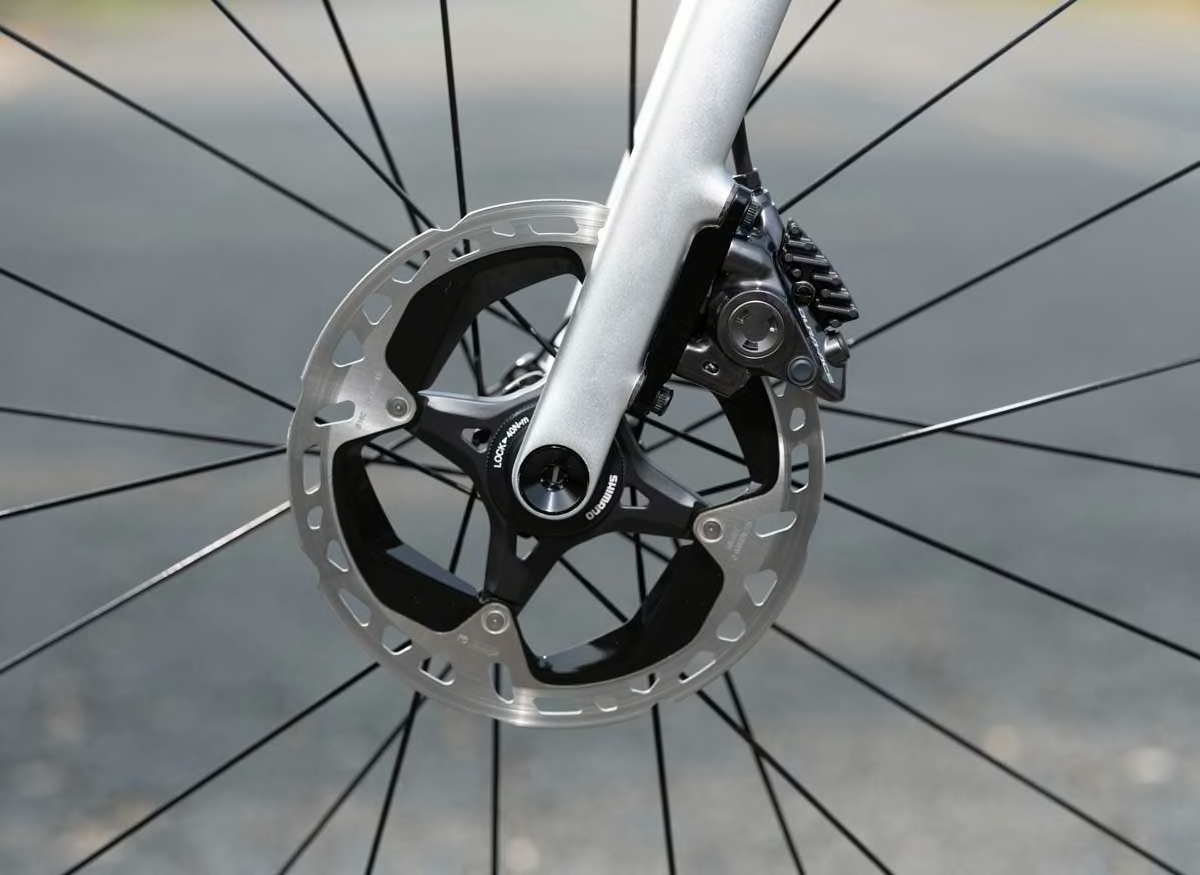
Brakes
Even very inexpensive bikes these days will come with some sort of disc brake rather than a rim brake that clasps the wheel. Less expensive bikes might get cable-actuated disc brakes, while slightly more expensive models are likely to have hydraulically actuated discs. They reduce the effort required of the rider to slow the bike for a sustained period, such as when descending a long hill. Disc brake systems have calipers mounted to the front and rear of the bike frame that slow the bike by making contact with a disc mounted to both front and rear wheel hubs, much like a car.
You can still find bikes with rim brakes—mostly very inexpensive bikes—but in large part, rim brakes are less effective at stopping a bike quickly and can be thrown out of alignment easily when removing and replacing a wheel during a tire change. We strongly recommend disc brakes for any new bike purchase, especially for better wet-weather performance.
If you are new to using disc brakes on a bike, don’t press on the brake lever if you remove the wheels. That will push the piston in, and you won’t be able to reinstall the wheel without assistance. Your local bike shop can show you how to transport a disc brake-equipped bike with the wheels removed.
PHOTO: SHIMANO
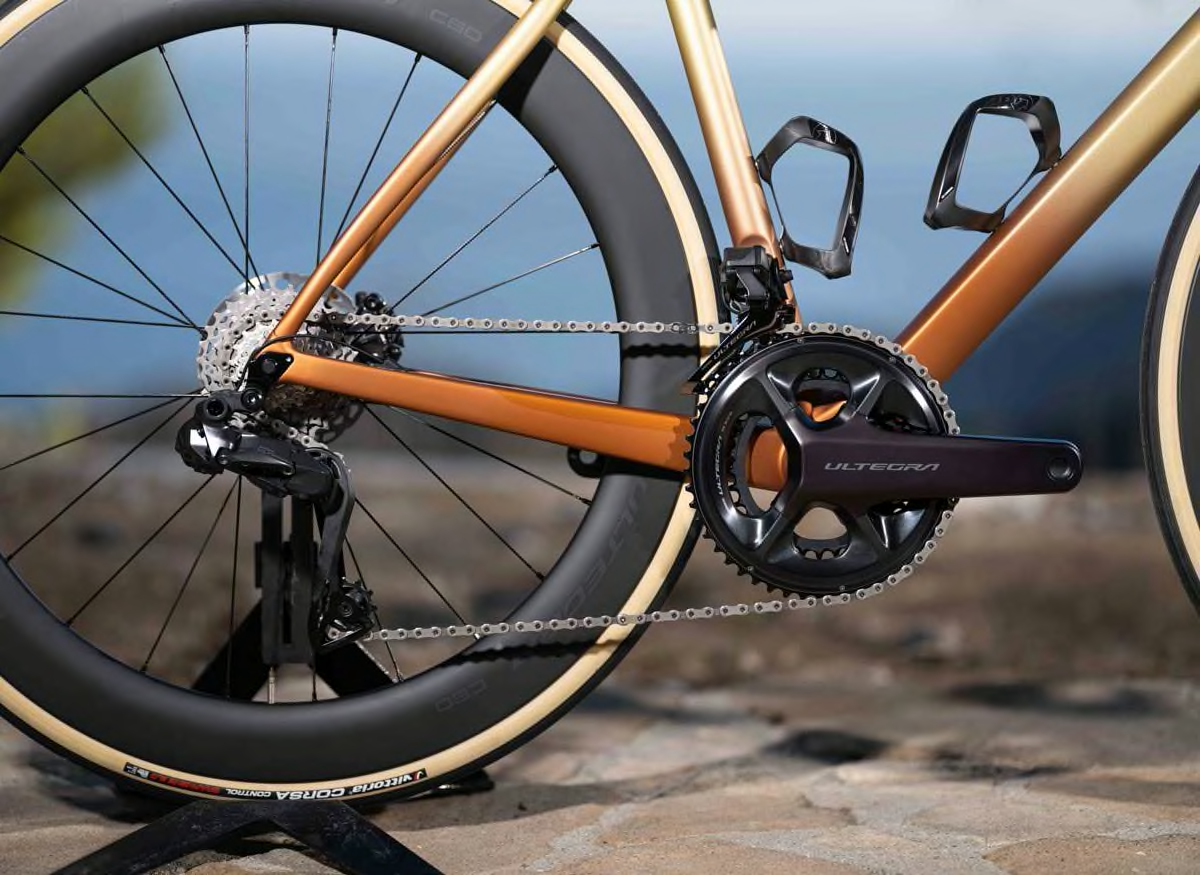
Drivetrain
A bicycle’s chain runs between the crankset in the center of the bike, by the pedals, and the cassette attached to the rear hub, where gears are stacked. Thanks to the expansion of rear cassette sizes (up to and even beyond 12-speed clusters are no longer uncommon), many bike manufacturers are dropping the number of chainrings at the crankset. Former double or triple cranksets have given way to a single front chainring, with all the gear changes handled by only a rear derailleur. That, in turn, means having only a single shifter, and the reduced mechanical complexity makes shifting easier for most riders. This also reduces wear and routine maintenance.
E-bikes are seeing the rise of automatic transmissions, and even loaner e-bikes from programs like Citi Bike in New York City now have automatic transmissions. These work much like they do in a car, where the rider simply pedals and the gear changes occur within a (usually) enclosed cluster. Another option to consider is a belt-driven transmission. The advantage is a greaseless system that’s impervious to rust and requires far less frequent maintenance. But belt drives tend to be heavier than conventional transmissions, making them more common on e-bikes, where total bike weight has less affect on rider effort.
PHOTO: SHIMANO
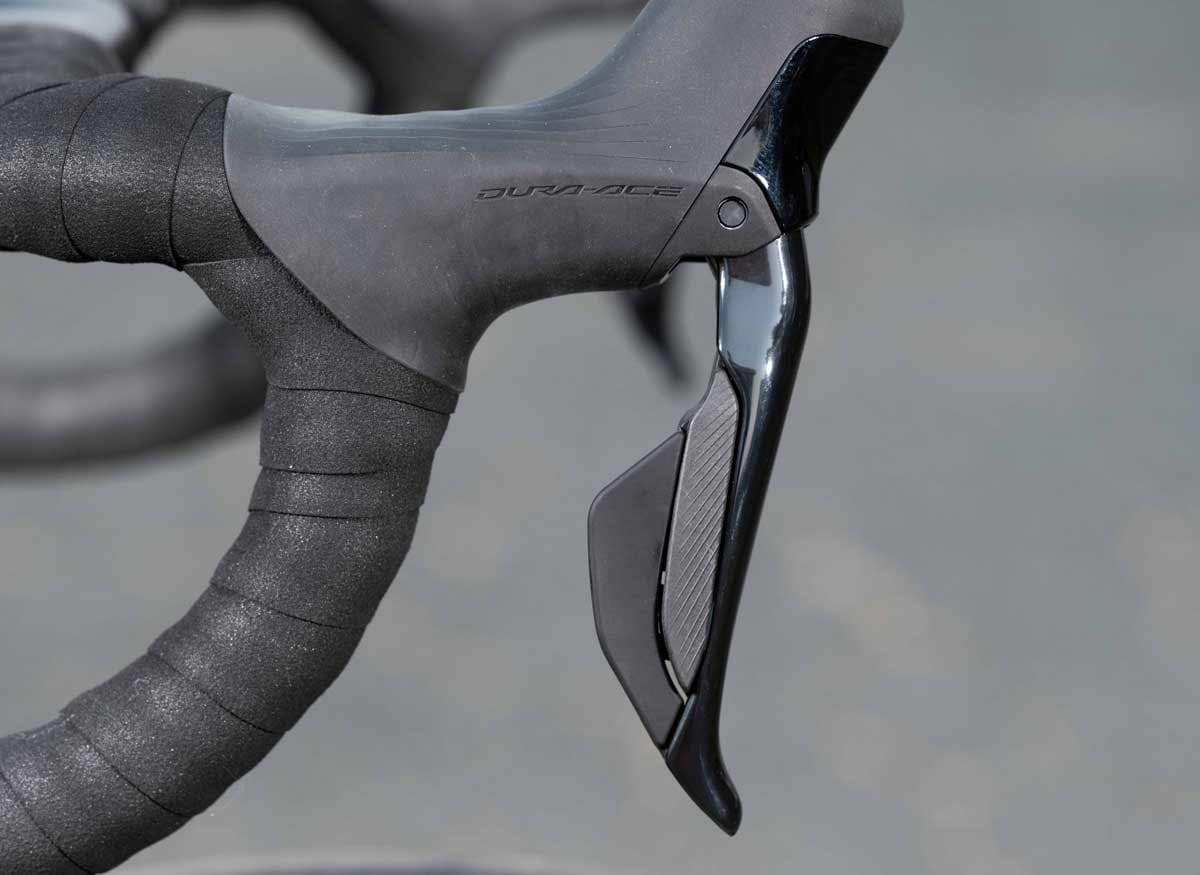
Shifters
With the demise of front gears on some bikes, particularly on electric, gravel, cruiser, and comfort bikes, many come with a single shifter, where a rear derailleur moves between the sprockets on the rear cassette. There are still multiple styles of shifters on the market. For example, mountain bikes may use a twist device that you roll around a collar on the handlebar, or triggers (push a thumb lever to shift up the cog set to gears that allow you to climb steeper grades; click a trigger to drop the chain down the cassette as you increase speed).
Cruisers and some drop-bar bikes use lever shifters that work on a similar principle to triggers, although some may use separate levers to control up- and downshifts. Most drop-bar bikes have “brifters” (shown below), which combine the brake levers with shifters. Sometimes a single lever is indexed: A longer push controls upshifts, while a shorter tap engages a downshift.
Electric shifting is found on most high-end road and gravel bikes, and even some midlevel ones. Instead of having a metal cable connecting the shift lever to the front and/or rear derailleur, the connection is an electrical wire or even wireless. The advantages are that gear changes are effortless and consistent, advanced users can customize the controls, and there aren’t any cables to stretch or wear out. On the downside, you need to make sure the battery or batteries are charged, and the components cost more to buy and, if you crash or break them, replace.
PHOTO: SHIMANO
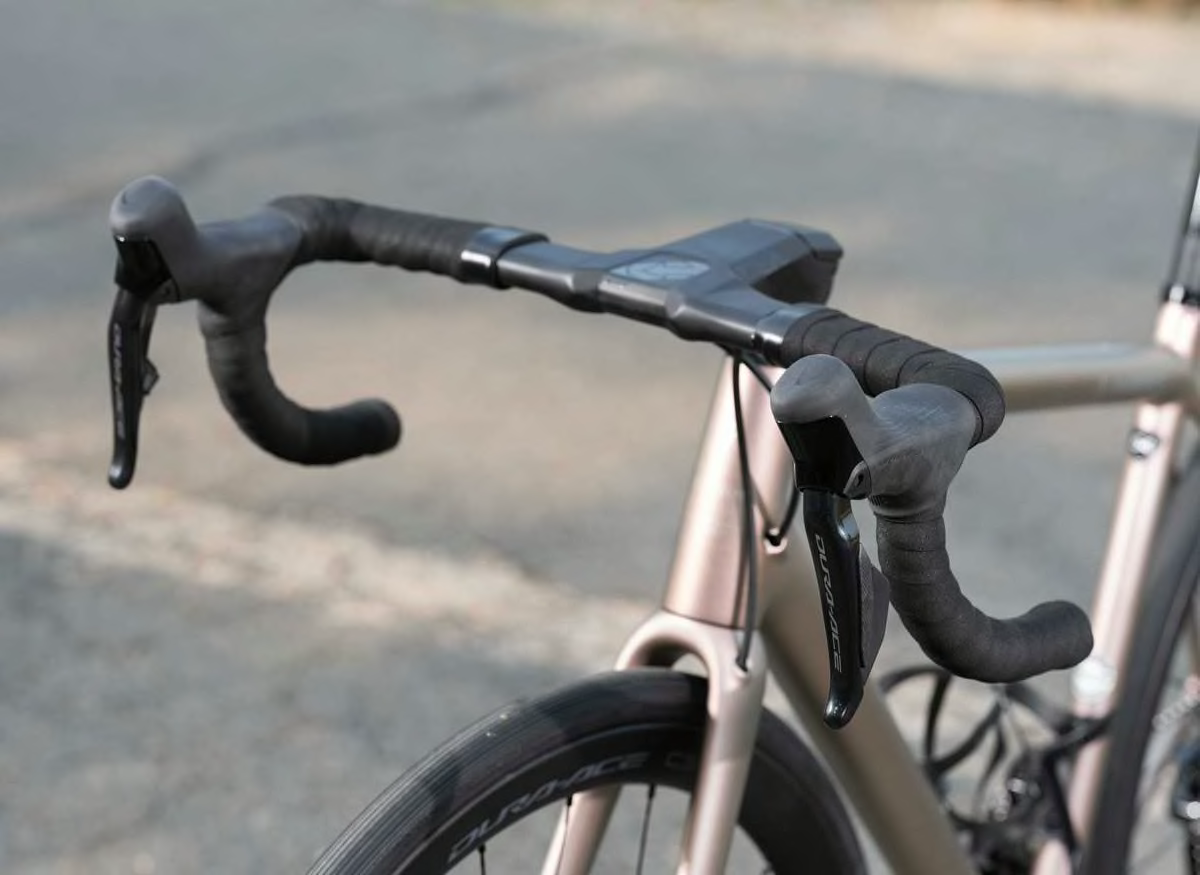
Handlebars
High-rise handlebars let you sit fairly upright. The curved drop bars on conventional road bikes allow an aerodynamic, fully bent position. Handlebars and stems can be swapped to improve riding position, adjusting the height and grip. Different riders have different preferences. If you can’t get comfortable, consider replacing the handlebars or stem with a different type or a different sweep, bend, or rise.
PHOTO: SHIMANO
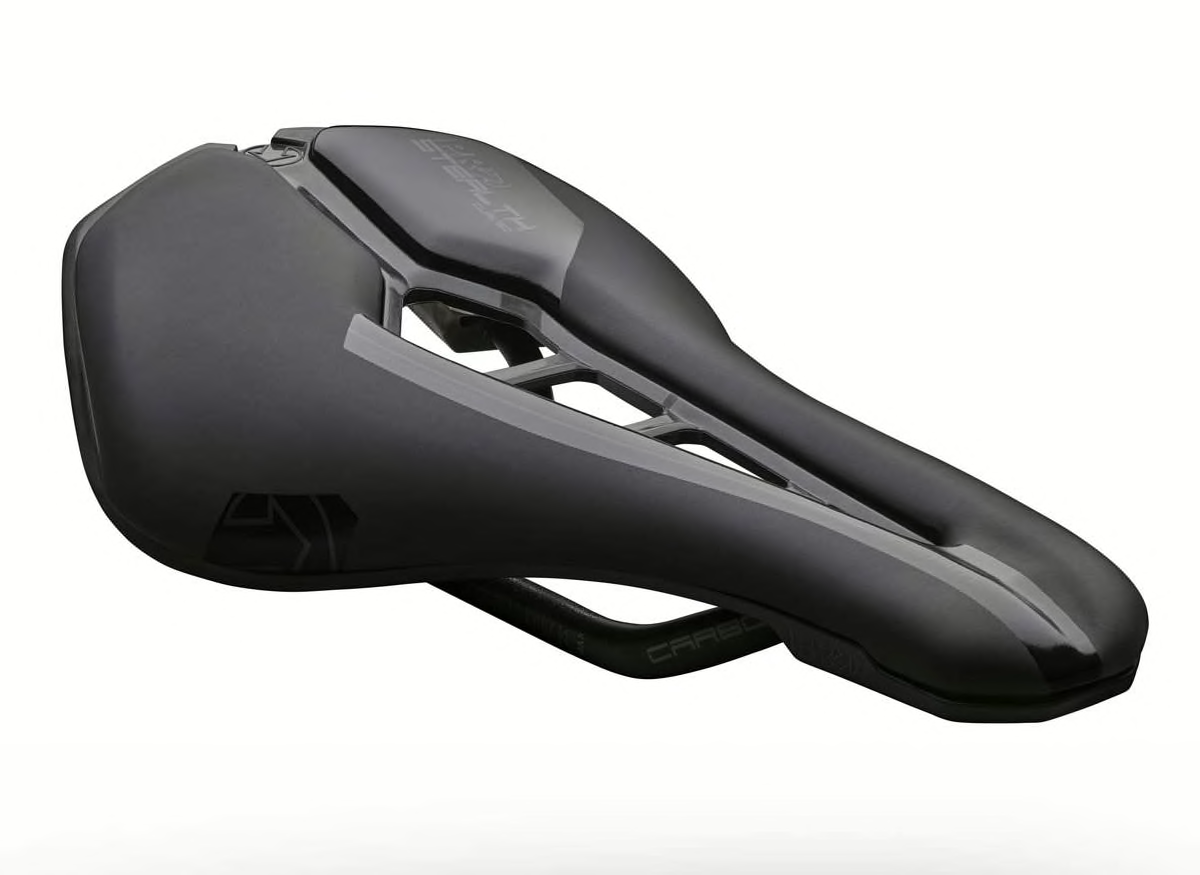
Saddle
Think of a saddle much like shoes: You wouldn’t wear too-big or too-small footwear, so don’t automatically accept the default saddle that comes with a bike. It has to fit your body because it’s where most of your weight sits when you ride. More performance-oriented bikes may get a narrower or harder saddle, which is lighter and allows a rider to more quickly adjust how a bike leans in a corner, while a wider, softer saddle on a cruiser might mute some of those inputs but feel more comfortable.
Work with a bike shop to measure the distance between your sit bones and the fore-or-aft angle of the nose of the saddle so that the perch will stay comfortable over long miles. It may sound counterintuitive, but a smaller, harder saddle may be a better choice than a thick, padded one. Padded bicycle shorts can help you remain comfortable while still maintaining proper contact between your sit bones and the saddle.
Keep in mind that a bike shop will help fit you to the bike so that you can safely operate it. But it may charge extra for a more comprehensive bike-fitting session. This is a wise investment, particularly if you plan to ride extensively. An improper fit can cause discomfort or pain; at the least, it will make bike rides less enjoyable. The money spent on a 30- or 60-minute session will be well worth it down the road.
PHOTO: SHIMANO
Brakes
Even very inexpensive bikes these days will come with some sort of disc brake rather than a rim brake that clasps the wheel. Less expensive bikes might get cable-actuated disc brakes, while slightly more expensive models are likely to have hydraulically actuated discs. They reduce the effort required of the rider to slow the bike for a sustained period, such as when descending a long hill. Disc brake systems have calipers mounted to the front and rear of the bike frame that slow the bike by making contact with a disc mounted to both front and rear wheel hubs, much like a car.
You can still find bikes with rim brakes—mostly very inexpensive bikes—but in large part, rim brakes are less effective at stopping a bike quickly and can be thrown out of alignment easily when removing and replacing a wheel during a tire change. We strongly recommend disc brakes for any new bike purchase, especially for better wet-weather performance.
If you are new to using disc brakes on a bike, don’t press on the brake lever if you remove the wheels. That will push the piston in, and you won’t be able to reinstall the wheel without assistance. Your local bike shop can show you how to transport a disc brake-equipped bike with the wheels removed.
PHOTO: SHIMANO
Drivetrain
A bicycle’s chain runs between the crankset in the center of the bike, by the pedals, and the cassette attached to the rear hub, where gears are stacked. Thanks to the expansion of rear cassette sizes (up to and even beyond 12-speed clusters are no longer uncommon), many bike manufacturers are dropping the number of chainrings at the crankset. Former double or triple cranksets have given way to a single front chainring, with all the gear changes handled by only a rear derailleur. That, in turn, means having only a single shifter, and the reduced mechanical complexity makes shifting easier for most riders. This also reduces wear and routine maintenance.
E-bikes are seeing the rise of automatic transmissions, and even loaner e-bikes from programs like Citi Bike in New York City now have automatic transmissions. These work much like they do in a car, where the rider simply pedals and the gear changes occur within a (usually) enclosed cluster. Another option to consider is a belt-driven transmission. The advantage is a greaseless system that’s impervious to rust and requires far less frequent maintenance. But belt drives tend to be heavier than conventional transmissions, making them more common on e-bikes, where total bike weight has less affect on rider effort.
PHOTO: SHIMANO
Shifters
With the demise of front gears on some bikes, particularly on electric, gravel, cruiser, and comfort bikes, many come with a single shifter, where a rear derailleur moves between the sprockets on the rear cassette. There are still multiple styles of shifters on the market. For example, mountain bikes may use a twist device that you roll around a collar on the handlebar, or triggers (push a thumb lever to shift up the cog set to gears that allow you to climb steeper grades; click a trigger to drop the chain down the cassette as you increase speed).
Cruisers and some drop-bar bikes use lever shifters that work on a similar principle to triggers, although some may use separate levers to control up- and downshifts. Most drop-bar bikes have “brifters” (shown below), which combine the brake levers with shifters. Sometimes a single lever is indexed: A longer push controls upshifts, while a shorter tap engages a downshift.
Electric shifting is found on most high-end road and gravel bikes, and even some midlevel ones. Instead of having a metal cable connecting the shift lever to the front and/or rear derailleur, the connection is an electrical wire or even wireless. The advantages are that gear changes are effortless and consistent, advanced users can customize the controls, and there aren’t any cables to stretch or wear out. On the downside, you need to make sure the battery or batteries are charged, and the components cost more to buy and, if you crash or break them, replace.
PHOTO: SHIMANO
Handlebars
High-rise handlebars let you sit fairly upright. The curved drop bars on conventional road bikes allow an aerodynamic, fully bent position. Handlebars and stems can be swapped to improve riding position, adjusting the height and grip. Different riders have different preferences. If you can’t get comfortable, consider replacing the handlebars or stem with a different type or a different sweep, bend, or rise.
PHOTO: SHIMANO
Saddle
Think of a saddle much like shoes: You wouldn’t wear too-big or too-small footwear, so don’t automatically accept the default saddle that comes with a bike. It has to fit your body because it’s where most of your weight sits when you ride. More performance-oriented bikes may get a narrower or harder saddle, which is lighter and allows a rider to more quickly adjust how a bike leans in a corner, while a wider, softer saddle on a cruiser might mute some of those inputs but feel more comfortable.
Work with a bike shop to measure the distance between your sit bones and the fore-or-aft angle of the nose of the saddle so that the perch will stay comfortable over long miles. It may sound counterintuitive, but a smaller, harder saddle may be a better choice than a thick, padded one. Padded bicycle shorts can help you remain comfortable while still maintaining proper contact between your sit bones and the saddle.
Keep in mind that a bike shop will help fit you to the bike so that you can safely operate it. But it may charge extra for a more comprehensive bike-fitting session. This is a wise investment, particularly if you plan to ride extensively. An improper fit can cause discomfort or pain; at the least, it will make bike rides less enjoyable. The money spent on a 30- or 60-minute session will be well worth it down the road.
PHOTO: SHIMANO
Brands
These are some of the larger bike brands on the market. Their profiles will help you learn about the manufacturer and what it offers.
Owned by Dorel Industries, Cannondale is headquartered in Wilton, Conn. It designs and produces a wide range of bicycles. Its product lines include fitness, mountain, road, specialty, urban, women’s, and electric bikes. They’re available at specialty bike shops and independent dealers.
Based in Dieren, the Netherlands, Gazelle is over a century old. It still makes its products at its headquarters. The company’s line is now focused on electric bikes starting at $1,500.
Giant Bicycles’ headquarters is in Taiwan, with its U.S. operations based in Newbury Park, Calif. Giant offers bicycles in the following categories: children’s, mountain, gravel, road, and electric. They’re sold through specialty shops.
Jamis is an American company based in Northvale, N.J. Its product lines include mountain, road/gravel, urban, recreation, e-bike, and youth bikes. Jamis bikes are sold at specialty dealers.
Rad, based in Seattle, makes only electric bikes. It has been a direct-to-consumer seller but is also opening retail stores nationwide; it offers delivery and assembly support. Bikes are mostly city/commuter style, but Rad also sells cargo bikes well-suited for running errands.
Raleigh, which has its headquarters in Kent, Wash., is one arm of the same corporation that makes Diamondback bikes. Raleigh product lines include urban, kids, fitness, and commuter-focused models, and they are available at specialty stores nationwide.
Specialized is based in Morgan Hill, Calif. It offers BMX, children’s, mountain, road, gravel, street (fitness and comfort), and women’s bikes, and many of these categories also include electric models. They’re available at specialty bike shops and independent dealers.
Tern is a Taiwanese company that’s big on sustainability and well-known for folding bikes, including electric and cargo models.
Trek Bicycles, based in Waterloo, Wis., has been making bikes since 1976. It still manufactures some of its higher-end bikes domestically, unlike the bulk of larger U.S.-based brands. Its product line includes children’s, mountain, road, urban, and women’s bikes, as well as electric bikes across most of these same categories. The bikes are available at specialty shops and independent dealers.



























